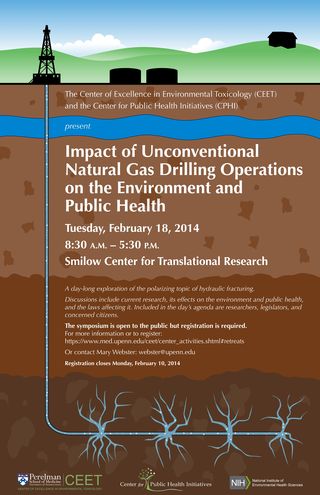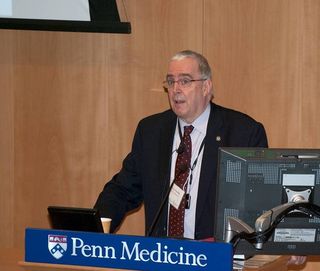 Last week the Center of Excellence in Environmental Toxicology (CEET) and the Center for Public Health Initiatives (CPHI) at the University of Pennsylvania co-hosted a symposium on the public health effects of natural gas drilling operations. Their aim was to profile the state of the science in this contentious field. Stakeholders from four major affected groups – government, academia, industry, and concerned citizens participated as speakers and attendees.
Last week the Center of Excellence in Environmental Toxicology (CEET) and the Center for Public Health Initiatives (CPHI) at the University of Pennsylvania co-hosted a symposium on the public health effects of natural gas drilling operations. Their aim was to profile the state of the science in this contentious field. Stakeholders from four major affected groups – government, academia, industry, and concerned citizens participated as speakers and attendees.
It was Aubrey Miller, MD, MPH, senior medical advisor to the National Institute of Environmental Health Sciences (CEET’s funder), in the last session of the day, “Where Do We Go From Here?,” who put the goal of the symposium into perspective for me: A PubMed search he ran on hydraulic fracturing came up with only a small handful of papers regarding the health effects or exposure information in this database of peer-reviewed literature, even though there are reportedly more than 52,000 wells in the US, with as many as 15 million Americans living within one mile of hydraulic fracturing activities.
“Our hope is that respectful discussion on this broad range of issues will provide participants with information to embrace evidence-based decision making,” wrote CEET director Trevor Penning, PhD, and CPHI director Jennifer Pinto-Martin, PhD, MPH in their welcome to attendees, addressing this imbalance of information versus the ubiquity of this relatively new energy-extraction process.
Hydraulic fracturing, colloquially known as fracking, is a process that forcibly injects a mixture of fluids into shale formations deep below the earth’s surface. This process fractures -- technically, creates a fissure within -- the rock in order to release natural gas and oil trapped inside. In Pennsylvania, this non-renewable resource is part of a large geological formational called the Marcellus Shale, with roughly half of the state lying above the formation.
For many at the meeting, unconventional natural gas drilling operations seemed to come “out of nowhere” about five years ago within the Commonwealth. Still, the answer to the question of the potential public health and environmental effects of hydraulic fracturing on air and water quality remains unclear.
Much data is to come in the next year or two, according to many of the symposium’s talks. View the talks and discussions
here for details.
For example, a draft report of an ongoing EPA nationwide study on the impact of drilling on drinking water is due out later this year. In addition, to get baseline environmental data, the USGS is in the midst of gathering data on methane and other chemicals and substances in groundwater in areas with and without drilling.
 CEET is part of an NIEHS Inter Center Working Group and Penning told the audience about three ongoing, collaborative studies from this group: one on the perception of the public health risk effects; another with Columbia University on groundwater quality and health outcomes in areas with and without drilling, and a third contributing data to the Harvard WorldMap Fracking Research Repository, a mapping system for tracking multiple types of information, for example exposure, economic impact, regulatory, water quality, geological formations, proximity of wells to aquifers, among other factors.
CEET is part of an NIEHS Inter Center Working Group and Penning told the audience about three ongoing, collaborative studies from this group: one on the perception of the public health risk effects; another with Columbia University on groundwater quality and health outcomes in areas with and without drilling, and a third contributing data to the Harvard WorldMap Fracking Research Repository, a mapping system for tracking multiple types of information, for example exposure, economic impact, regulatory, water quality, geological formations, proximity of wells to aquifers, among other factors.
Brian Schwartz from the Johns Hopkins Bloomberg School of Public Health along with Geisinger Health System in north central Pennsylvania also described an epidemiological study using electronic health record data to look for possible associations of the incidence of asthma, cardiovascular disease, and obesity with proximity to hydraulic fracturing operations.
Penning indicated that the symposium was a “first of its kind,” in which the status of ongoing environmental and environmental health studies were profiled. Other symposia and workshops on hydraulic fracturing have focused predominately on what studies need to be performed without providing sorely needed data.